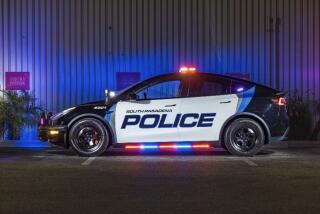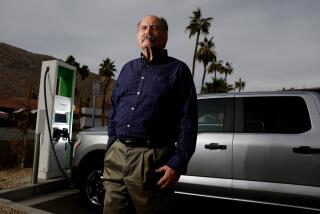The Region - News from Oct. 17, 2001
The names are appropriate--for both brand and model.
Ford Motor Co.’s newest electric vehicle, due to hit the U.S. market by early next summer, is definitely a city car. It makes little sense out in the country where distances are long and roads wide open.
And you do, indeed, have to think about it: where it is best to use it, which roads to drive it on and which routes are best to take to minimize juice-gulping obstacles.
That said, the Think City car is easy to love, assuming it meets your needs.
The European-market version being introduced in a trial program in California gives a pretty good advance peek at what the final U.S. version will be (just add about 3 inches of length, dual air bags, an air conditioner and a slightly more powerful battery pack for a higher top speed).
The Norwegian-bred City is a great example of Scandinavian minimalist design on wheels: a practical two-seat econobox that whizzes along at a perfectly proper pace for city streets, generates a little bit of its own electricity each time you hit the brakes, carries you in reasonable comfort, totes a ton of stuff in its surprisingly spacious cargo area and does it all in quirky style--an electric bug for the new century.
What it isn’t: a great family car, a good choice for someone living in the mountains or foothills (hilly San Francisco with its relatively short intracity commuting distances excepted), a hot rod.
Top speed is 56 mph--expect to get about 65 mph in the U.S. version--and though the electric motor is rated at the equivalent of just 36 horsepower, it uses the low-end torque at which electric cars excel to turn a respectable zero-to-30-mph time of 7.0 seconds.
Outside, the Think City is either cute or ugly; it’s all in the eye of the beholder. Its tall, slightly boxy cabin is preceded by an almost nonexistent bug-eyed nose, all made of molded plastic that is lightweight and dent-and rust-proof. As a bonus, the colors--it comes with a white top and one of seven body hues--are molded in, so scratches barely show.
The body is supported by a high-strength aluminum upper frame and rides on a steel frame that also holds the batteries.
All interiors are deep blue, with a pair of clock-style white analog gauges providing information about speed and energy consumption (there are digital readouts on the speedometer for the clock, accumulated mileage, warning messages and trip meter). The nicely laid-out center stack houses big, easy-to-use controls for heater (and air in the U.S. model), ventilation system and stereo. The lever controlling the electronic transmission--which, as is normal for electric vehicles, has just one forward speed--is mounted just below the ventilation controls in the center of the dashboard.
The seats are thin but well padded and, though not particularly adjustable, are supportive and comfortable over the relatively short duration of most trips. You will feel bumps in the road, though.
There is lots of legroom and enough headroom for a pro basketballer. The seating position is moderately high, so visibility is good, and enhanced rearward by the glass tailgate.
Behind the seat is a large carpeted cargo area, accessible through that flip-up tailgate. Cargo capacity is 12.4 cubic feet. If that doesn’t mean much to you, then suffice it to say that it easily swallows a week’s worth of groceries for a family of three.
My only dislikes centered on access to the rear: I hated that the seats didn’t flip forward to provide better access from the passenger compartment, and I didn’t like the omission of a latch and lock on the tailgate. The only way to open it is by pressing a button on the steering column. The Think City will meet all U.S. crash standards, is freeway legal (although I wouldn’t recommend freeway use in Southern California, where typical speeds even in the slow lanes are over 65 mph) and can be used just like a regular car within its range limitations.
That’s the critical qualifier: range limitations.
The faster you go, the more juice you use. The steeper the hill you must climb, the more juice you use. The heavier the load you carry, the more juice you use.
Conversely, as you use the brakes in stop-and-go traffic, electricity is pumped back into the batteries by the regenerative braking system. The longer you can coast down hills with the re-gen function turned on, the more juice produced. The slower the speeds and gentler the acceleration, the more juice you conserve.
Electric car drivers quickly learn how to get the most out of their vehicle. The maximum range of the City is 53 miles, but that’s like EPA-estimated gas mileage, achievable only under ideal driving conditions that rarely occur in the real world.
On Day 1 of my week with a City, I drove as I drive my own car. I hate to be the last one through the intersection and detest poking along in a pack of traffic if there is an open space ahead.
In that vein, I started with a full battery pack and at the end of my 34-mile round-trip commute had a mere 2% of the battery charge left and was limping along in the car’s emergency mode, which kicks in to limit speed when the charge drops to 10% or less.
One caveat: We live atop a hill, and the trip from bottom to top is about two miles of steep grade. I had 20% of the charge left when I reached the foot of the hill on my way home from work that first day. I kept my foot on the floor and charged up the hill as fast as I could--the City topped out at 45 mph and then gradually sunk back to a sedate 31 mph as gravity’s tug overwhelmed the electric motor’s torque--and used up 18% of the charge in that mere two miles.
On my final day with the City as commuter car, I adopted a Mr. Milquetoast approach to driving. I puttered across intersections at a leisurely pace, never exceeded posted speed limits and tapped the brakes long before I really needed to in order to prolong the regenerative process.
As a result, I had almost 32% of a charge left when I hit the bottom of the hill that evening. And by taking it easy on the way up (and keeping far to the right so folks speeding by wouldn’t beep their horns), I had almost 19% left when I got home. That would have given me eight to 10 additional miles of travel and extended the range that day to about 43 miles, hill and all.
During the week, I took my father to medical appointments on two mornings before work, made stops at the bank and post office one day and stopped by the supermarket on the way home one evening to pick up a few items we’d run out of--in other words, I did all the things a working commuter usually does.
The only difference? I did ‘em in a car that hummed along not with an internal combustion roar, but with an electric whine that the stereo system--with standard single-disc CD player--nicely canceled out.
I recharged each night from a 220-volt outlet in my garage, and even though I wasn’t hooked up with a separate meter to get the off-peak rate of 8 cents a kilowatt-hour, a week’s worth of charges added less than $10 to the month’s electric bill. With off-peak billing, it would have been less than $6.
I put about 220 miles on the City in the week I had it--about the same I put on my regular car if we are just hanging around the house on weekends. But it would have cost me more than $20 to refill my gas tank, so I saved 50% on fuel.
The City looks a bit top-heavy--several neighbors voiced concern that it would be easy to tip. But with 530 pounds of batteries slung in a steel frame under the seats, the center of gravity is quite low and it corners like a champ--albeit a champ limited by its 13-inch tires and a fairly rudimentary suspension system.
Final Words: The Think City could be a great second, or third, car for those with short commutes and concerns about the environment. It’s also a neat idea for high school kids who could use a set of wheels but don’t need to get where they are going at 90 mph or to travel farther than 25 miles from home.
The City won’t replace the family sedan, but then again, it is not intended to.
Ford insiders whisper about a sticker price of just under $20,000, and state and federal rebates would get the actual cost to the consumer down to about $13,000. With $1-a-day fuel costs and little or no motor maintenance, it’s beginning to sound like an idea whose time is now at hand.
*
Times staff writer John O’Dell covers autos for Highway 1 and the Business section. He can be reached at [email protected].
*
THINKING BIG: Marketing: The Think City is already proving popular in a test program with five California Ford dealers. C1






